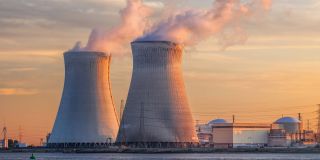66th Carnival of Nuclear Energy Bloggers
Box Scores

A message from Goodway
Dry Ice Blasting: A Game-Changer for Safe Cleaning and Decontamination in Nuclear Power Plants
Box Scores
The utility's board of directors will spend $4 billion-$5 billion completing the 1,260 MW reactor
Curbing domestic oil use is a key driver
Two members of the American Nuclear Society were named Fellows during the June 2011 ANS annual conference. These awards were presented in recognition of the Fellows' significant contributions and achievements to nuclear science and technology.
The nuclear renaissance began in the 1990s when reactors began to achieve better than 90-percent up time. The next step is to build new plants on time and within budget. - Nuclear Energy Institute
The first two parts of this series (here and here) presented historical trends in electricity generation in California, and the growing use of in-state natural gas and imports of electricity from grids in neighboring states. They also showed that the use of "Unbundled Renewable Energy Credits" could meet the 33 percent renewable portfolio on paper, but may not benefit consumers in California with actual delivery of electricity.
A recent article called "Earthquake, Tsunami, and Nuclear Power in Japan," written by Karen Street has gotten a lot of attention over the past week. It is a well written and comprehensive look at how humanitarian issues interface with energy issues. Shortly after the article was published in Friends Journal, Street was contacted by a personal friend (and long-time nuclear opponent) with the question, "How do I get involved?"
The American Nuclear Society issues a comprehensive spent fuel report
Vermont Yankee's opponents continue their campaign
The nuclear renaissance began in the 1990s when reactors began to achieve better than 90% up time. The next step is to build new plants on time and within budget. - NEI
Statement identifies advantages, makes recommendations
Japanese and U.S. counterparts face major challenges over Fukishima, but for different reasons
The American Nuclear Society's Board of Directors on June 30 during the ANS Annual Conference in Hollywood, Fla., approved the creation of three new student sections:
During the past few days, I have been blessed with the opportunity to eavesdrop on an intriguing e-mail exchange involving Ted Rockwell, one of my technical heroes. Rockwell is a man whose involvement in nuclear technology dates back to the Manhattan Project, where he served as a member of a "Tiger Team" of young engineers who were assigned the task of making process improvements at Y-12.
The heat is on across the United States. The nation's 104 nuclear reactors are providing electricity to keep people cool without warming the planet. Nuclear energy can help save habitat for polar bears.
A report by a Nuclear Regulatory Commission staff task force calls for sweeping regulatory change, but also acknowledges that information about the Fukushima accident is unavailable, unreliable, or ambiguous. What should be the response in the United States to the events in Japan?
A recent Reuters news article describes how New York State will require a reduction in cooling water intake for power plants and other industrial facilities, to reduce fish kills by 90 percent. The article goes on to say that the state is planning to use this rule to force the Indian Point nuclear power plant to install a $2-billion closed-cycle cooling system.